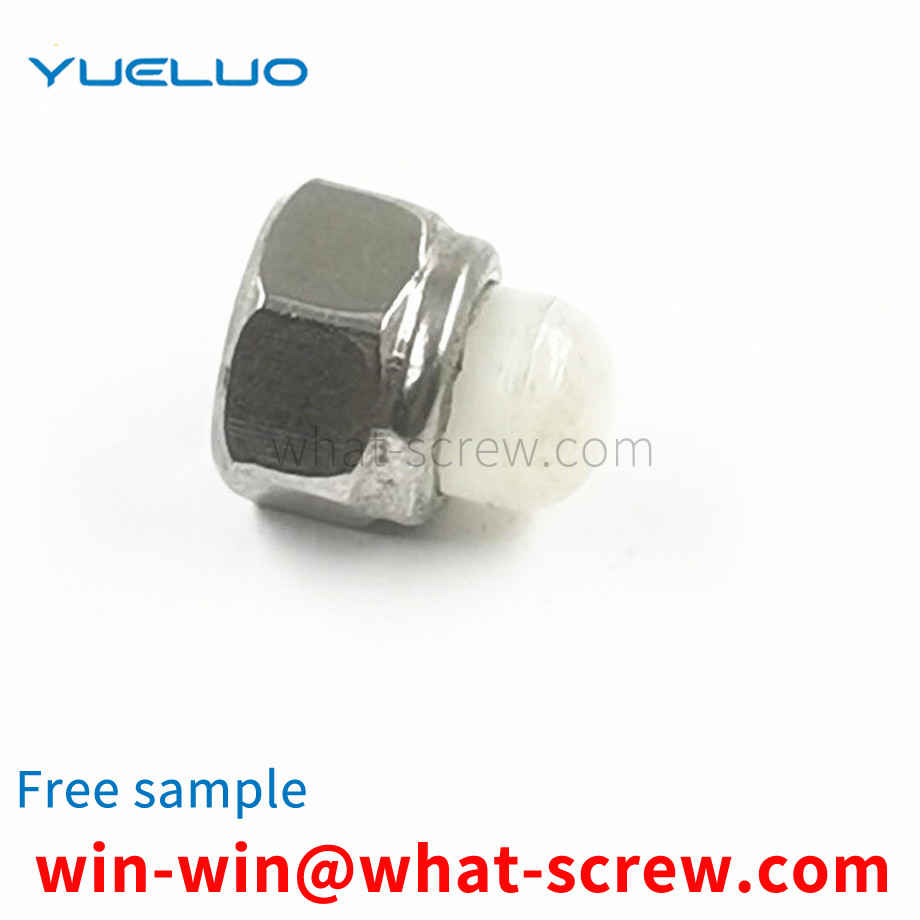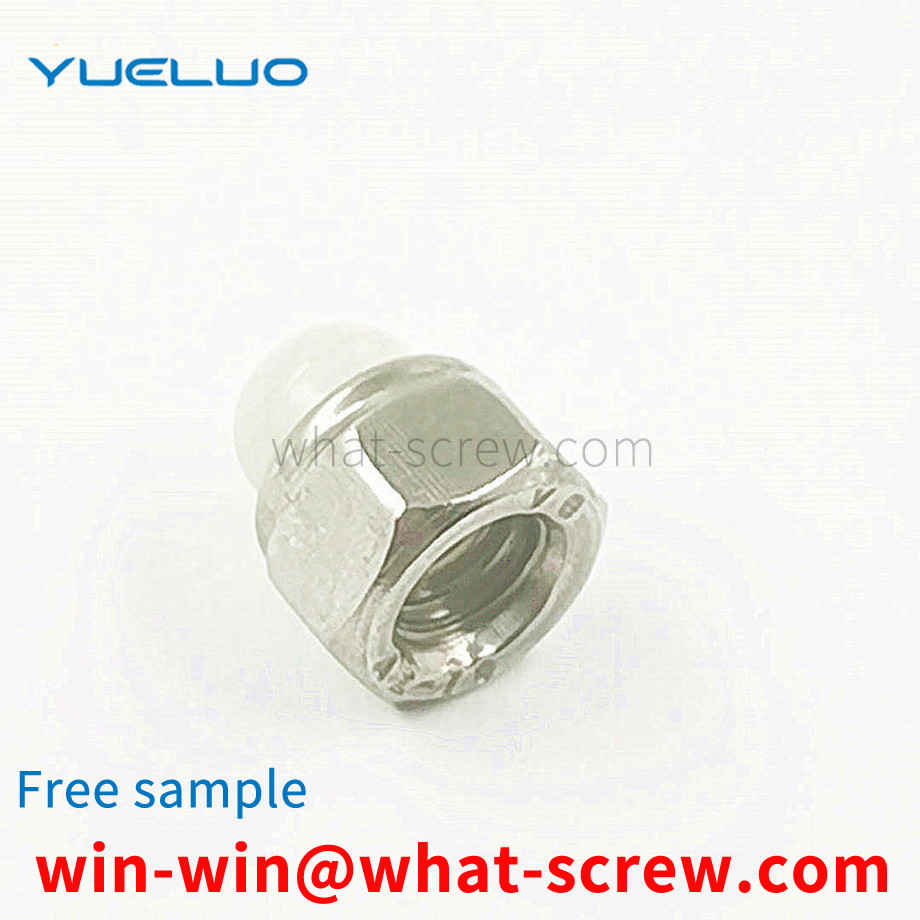The nut specification table is to unify all kinds of nuts in detail, and use the table to subdivide some specifications of the nuts. There are many types of nuts, and there are nuts of different materials. Each type of nut has different specifications, and each type of screw also has its mechanical properties and functions. · Square nut grade C GB 39-88 · Hexagonal nut grade C GB /T41-2000 · Hexagonal thick nut GB 56-88 · Wing nut GB 62-88 · Ring nut GB 63-88 · Combined cap nut GB 802 -88 · Spherical Hex Nut GB 804-88 · Fastening Nut GB 805-88 Knurled High Nut GB 806-88 · Knurled Thin Nut GB 807-88 · Small Hexagonal Extra Flat Fine Thread Nut GB 808-88 · Embedded Round nut GB 809-88 · Small round nut GB 810-88 · Round nut GB 812-88 End hole round nut GB 815-88 · Side hole round nut GB 816-88 · Slotted round nut GB 817-88 · Type 1 non-metallic insert hexagonal lock nut GB /T 889.1-2000 · Type 1 non-metallic insert hexagonal lock nut with fine thread GB /T 889.2-2000 · Cap nut GB 923-88 · Type 1 hexagonal nut GB / T 6170-2000 · Type 1 Hexagonal Nuts with Fine Thread GB /T 6171-2000 · Hexagonal Thin Nuts GB /T 6172.1-2000 · Non-metallic Insert Hexagonal Locking Thin Nuts GB /T 6072.2-2000 · Hexagonal Thin Nuts with Fine Pitch GB /T 6173-2000 · Hexagonal thin nuts without chamfer GB /T 6174-2000 · Type 2 hexagon nuts GB /T 6175-2000 · Type 2 hexagon nuts with fine pitch GB /T 6176-2000 · Hexagon flange nuts GB / T 6177.1-2000 · Hexagon flange face nuts with fine pitch GB /T 6177.2-2000 · Type 1 hexagon slotted nut - Grade A and B GB 6178-86 · Type 1 hexagon slotted nut - Grade C GB 6179-86 · 2 Type Hexagonal Slotted Nuts-A and B Grades GB 6180-86 Hexagonal Slotted Thin Nuts-A and B Grades GB 6181-86 Type 2 Non-metallic Insert Hexagonal Lock Nuts GB/T 6182-2000 Non-metallic Inserts Hexagon flange face lock nuts for non-metal inserts GB /T 6183.1-2000 · Non-metallic insert hexagonal flange face lock nuts with fine thread GB /T 6183.2-2000 · Type 1 all-metal hexagonal lock nuts GB /T 6184-2000 · Type 2 all-metal hexagonal lock nut GB /T 6185.1-2000 · Type 2 all-metal hexagonal lock nut fine pitch GB /T 6185.2-2000 · Type 2 all-metal hexagonal lock nut Grade 9 GB /T 6186-2000 · Full Metal Hexagon Flange Face Lock Nuts GB /T 6187.1-2000 · All Metal Six Angle flange face locking nut fine pitch GB /T 6187.2-2000 · Type 1 hexagon slotted nut with fine pitch A and B grades GB 9457-88 · Type 2 hexagonal slotted nut with fine pitch A and B grade GB 9458-88 · Hexagonal Slotted Thin Nut Fine Thread Grade A and B GB 9459-88 · Welded Square Nut GB /T 13680-92 · Welded Hexagonal Nut GB /T 13681-92 · Flat Head Rivet Nut GB /T 17880.1-1999 · Countersunk Head Rivet Nut GB /T 17880.2-1999 · Small countersunk head rivet nuts GB /T 17880.3-1999 · 120° small countersunk head rivet nuts GB /T 17880.4-1999 · Flat head hexagonal rivet nuts GB /T 17880.5-1999 · Hexagonal nuts for precision machinery GB /T 18195-2000
The core rivet is a new type of riveting fastener that is very convenient for riveting. It can show its unique advantages in a relatively small space or in an environment where there is no rivet gun or a rivet gun cannot be used. Two or more connected parts can be riveted successfully by hitting the mandrel on one side with a hammer or other utensils. Core rivets can be divided into oblate head core rivets and countersunk head core rivets according to the shape of the brim of the nail cap. According to different material combinations, they can be divided into all aluminum core rivets, aluminum steel core rivets, and all stainless steel core rivets. Rivets, steel rivets, aluminum stainless steel rivets, plastic rivets, etc. Core rivets do not have to be riveted with manual riveting guns or pneumatic riveting guns like blind rivets. They have better riveting and convenience, and can be widely used in the riveting of various connected parts.
Although there are many types of self-tapping screws, they all have the following common points: (1) They are generally made of carburized steel (accounting for 99% of the total output). Also available in stainless steel or non-ferrous metals. (2) The product must be heat treated. Carbon steel self-tapping screws must be carburized, and stainless steel self-tapping screws must be solution hardened. In order to make the self-tapping screw meet the mechanical properties and performance required by the standard. (3) The product has high surface hardness and good core toughness. That is, inner softness and outer rigidity. This is a major feature of the performance requirements of self-tapping screws. If the surface hardness is low, it cannot be screwed into the matrix; if the toughness of the core is poor, it will break as soon as it is screwed, and it cannot be used. Therefore, inner soft outer steel is a very important requirement for self-tapping screws to meet the performance requirements. (4) The surface of the product needs surface protection treatment, generally electroplating treatment. The surface of some products must be treated with phosphate (phosphating), such as wallboard self-tapping screws are mostly phosphated. (5) Produced by cold heading process. It is recommended to use high-speed cold heading machine and high-speed thread rolling machine or high-speed planetary thread rolling machine for production. The emphasis here is on high speed to ensure product quality. Only self-tapping screws produced by high-speed machines have well-formed heads and high-quality threads.
The existing spring pads are generally composed of longitudinal support springs, transverse connection springs, support springs, frames and frame clips. (Commonly known as string spring) is a slender and constant warp spring, used to connect the longitudinal support spring. The support spring is located at the edge of the spring pad to increase the shear resistance of the spring pad and the support strength of the frame. The surrounding frame connects the spring to the spring. up, fixed. The existing treatment method is to first heat-process the longitudinal support spring and the support spring made of 70# steel wire through the winding spring in a chemical solution, arrange them, and fix and connect them with a string spring, a frame and a clamping piece. Because the string spring and the frame have not been chemically heat treated, there is a large internal stress. Therefore, this treatment method has two disadvantages. One is that the processing efficiency of the heat treatment support spring is low. Larger, the spring is easily deformed and the service life is affected. In addition, the chemical solution after heat treatment is easy to cause environmental pollution
The shaft and gear of financial self-service equipment are often connected by elastic straight groove cylindrical pins. When repairing, the traditional disassembly method is to use the shaft and gear as components. After disassembling together, align the punch with the elastic pin by hand, and use a hammer to remove the elastic pin. Pin out. With this disassembly method, the human hand is easily injured, and the disassembly efficiency is low.
We have many years of experience in the production and sales of screws, nuts, flat washers, etc. The main products are: high-strength self-locking nuts, lifting ring bolts, extended lifting ring bolts, flat head machine bolts and other products, we can provide you with suitable tightening screws. Firmware Solutions.



















 Service Hotline
Service Hotline




